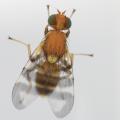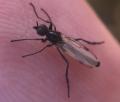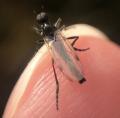Diptera.info :: Identification queries :: Diptera (adults)
Who is here? 1 guest(s)
|
Empididae? Anthomyiidae! (male)
|
|
| sarefo |
Posted on 18-06-2009 18:14
|
|
Member Location: Posts: 43 Joined: 22.03.08 |
if i remember correctly this fly was about 5 mm long, living in a bushy area of Cologne, Germany (May 31, 2009). It rather looks like a female Hilara maura, but then again i've got nothing but the insect-chinery to look at, so probably it's something else (there also is no body of water nearby). cheers! s. sarefo attached the following image:  [61.3Kb] Edited by sarefo on 18-06-2009 18:52 |
|
|
|
| pwalter |
Posted on 18-06-2009 18:19
|
|
Member Location: Miskolc, Hungary Posts: 3555 Joined: 06.11.08 |
Well, it's a bit far from Empididae - You can see a nice big Calyptra under the wing (whitish) so that means it's a Calyptrate (Muscidae and othes). Also, Hybotid's and Empidids have a spike-like mouth. This fly has a mouth for licking up things. Also, most Calyptrates tend to have a lot of and long hairs. This one is an Anthomyiid, male, characters are long abdomen which is very slender at the beginning, and eyes meet so it is a male. |
|
|
|
| Paul Beuk |
Posted on 18-06-2009 18:22
|
|
Super Administrator Location: Netherlands Posts: 19250 Joined: 11.05.04 |
Has an anthomyiid appearance to me
Paul - - - - Paul Beuk on https://diptera.info |
| sarefo |
Posted on 18-06-2009 18:43
|
|
Member Location: Posts: 43 Joined: 22.03.08 |
thanks for the hints! it's really interesting how time and again flies that look exactly the same to me belong to totally different families, probably one reason i stayed away from diptere identification for so long. let's see if i one day get a feeling for this (to me) hidden diversity :) |
|
|
|
| sarefo |
Posted on 18-06-2009 18:52
|
|
Member Location: Posts: 43 Joined: 22.03.08 |
so then this is a female Anthomyiid? (same date+location as the other one)
sarefo attached the following image:  [48.29Kb] |
|
|
|
| Michael Ackland |
Posted on 19-06-2009 13:04
|
|
Member Location: Dorset UK Posts: 680 Joined: 23.02.08 |
The first photo is a male anthomyiid, perhaps Hydrophoria or Hylemya, is the arista plumose? The second photo shows buccate (wide) parafacials and jowls, so is probably Leucophora; can't say male of female as the males are more approximated eyes, giving them better vision in laying their eggs in acalyptrate nests. The abdomen looks male from above, somewhat obscured. |
|
|
|
| sarefo |
Posted on 19-06-2009 13:58
|
|
Member Location: Posts: 43 Joined: 22.03.08 |
thanks for the info so far! so which ones have more approximated eyes? the females, because they lay the eggs into nests? i just thought it's a female because the eyes don't meet, but it turns out fly identification is not as simple as that ;) cheers! s. |
|
|
|
| Michael Ackland |
Posted on 19-06-2009 14:25
|
|
Member Location: Dorset UK Posts: 680 Joined: 23.02.08 |
I will rephrase my answer, it's a little ambiguous. Females in some groups of Leucophora have masculinized eyes, i.e. instead of being widely separated, they have adapted and become as in the males (which are often slightly separated). This is because of they need to have better vision in aculeate nests (host), Therefore males and females are very similar in this respect. I can't say which species in the British (or European) fauna this applies to witout checking my material. Certainly in the unistriata group. You would need to see the apex of the abdomen to say what sex in the photo. Females have hook-like spines on the cerci (end of ovipositor) for digging in sand. |
|
|
|
| Michael Ackland |
Posted on 19-06-2009 14:26
|
|
Member Location: Dorset UK Posts: 680 Joined: 23.02.08 |
I will rephrase my answer, it's a little ambiguous. Females in some groups of Leucophora have masculinized eyes, i.e. instead of being widely separated, they have adapted and become as in the males (which are often slightly separated). This is because of they need to have better vision in aculeate nests (host), Therefore males and females are very similar in this respect. I can't say which species in the British (or European) fauna this applies to witout checking my material. Certainly in the unistriata group. You would need to see the apex of the abdomen to say what sex in the photo. Females have hook-like spines on the cerci (end of ovipositor) for digging in sand. |
|
|
|
| sarefo |
Posted on 19-06-2009 14:30
|
|
Member Location: Posts: 43 Joined: 22.03.08 |
interesting. yes, that's what i thought you ment, just wanted to make sure. cheers! s. |
|
|
|
| Jump to Forum: |














 but don't see the image in the post.
but don't see the image in the post.
